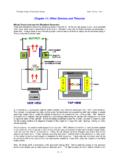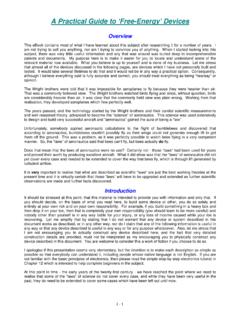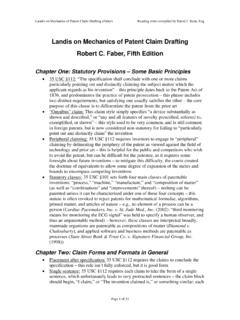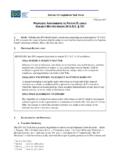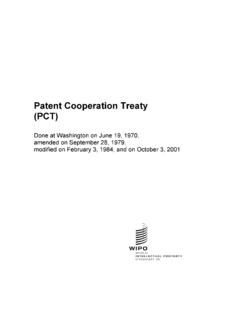Transcription of A Practical Guide to ‘Free Energy’ Devices
1 A Practical Guide to free energy Devices Device patent No 25: Last updated: 20th February 2007 Author: Patrick J. Kelly This patent application shows a very neat, self-powered electrical generator with a theoretical output of anything up to a COP of 59 when using cadmium selenide. The discussion of the theoretical aspects of the design includes a large amount of historical information and it covers the origin of the law of Conservation of energy which, in spite of being incorrect, has been for decades, a major obstacle to the scientific development of free - energy Devices . patent Application US 2007/0007844 A1 11th January 2007 Inventor: William N.
2 Barbat SELF-SUSTAINING ELECTRIC POWER GENERATOR UTILISING ELECTRONS OF LOW INERTIAL MASS TO MAGNIFY INDUCTIVE energy Filed: 6th March 2006 Assignee: Levitronics, Inc. Provisional application No. 60/697,729 filed on 8th July 2005 ABSTRACT Electrical oscillations in a metallic sending coil radiate inductive photons toward one or more energy -magnifying coils comprised of a photoconductor or doped semiconductor coating a metallic conductor, or comprised of a superconductor. Electrons of low inertial mass in the energy -magnifying coil(s) receive from the sending coil, a transverse force having no in-line backforce, which exempts this force from the energy -conservation rule.
3 The low-mass electrons in the energy -magnifying coil(s) receive increased acceleration proportional to normal electron mass divided by the lesser mass. Secondarily radiated inductive-photon energy is magnified proportionally to the electrons greater acceleration, squared, , the inductive- energy -magnification factor of CdSe photoelectrons with x normal electron mass is 59 times. Magnified inductive-photon energy from the energy -magnifying coil(s) induces oscillating electric energy in one or more metallic output coil(s) . The electric energy output exceeds the energy input if more of the magnified photon induction energy is directed toward the output coil(s) than is directed as a counter force to the sending coil.
4 After an external energy source initiates the oscillations, feedback from the generated surplus energy makes the device a self-sustaining generator of electric power for useful purposes. CROSS REFERENCE TO RELATED APPLICATION This application corresponds to, and claims the benefit under 35 119(e), of provisional application No. 60/697,729, filed on 8th July 2005, incorporated herein by reference in its entirety. FIELD This disclosure introduces a technical field in which Practical electrical energy is created in accordance with the overlooked exception to the energy -conservation rule that Herman von Helmholtz described in his 1847 doctrine on energy conservation: If .. bodies possess forces which depend upon time and velocity, or which act in directions other than lines which unite each pair of material points.
5 Then combinations of such bodies are possible in which force may be either lost or gained as infinitum . A transverse inductive force qualifies for Helmholtz s ad infinitum rule, but this force is not sufficient of itself to cause a greater energy output than input when applied to electrons of normal mass due to their unique charge-to-mass ratio. However, the increased acceleration of conduction electrons of less-then-normal inertial mass, as occurs in photoconductors, doped semiconductors, and superconductors, is proportional to the normal electron mass divided by the low electron mass, and the magnification of harnessable inductive energy is proportional to the square of the greater relative acceleration.
6 BACKGROUND Magnetic force also satisfies Helmholtz s exemption to the energy -conservation rule because magnetic force is transverse to the force that causes it, and magnetic force is determined by the relative velocity ( perpendicular to the connecting line) between electric charges. Magnification of magnetic force and energy was demonstrated by E. Leimer (1915) in the coil of a speaker phone and in the coil of a galvanometer when he irradiated a radio antenna-wire with radium. A 10 milligram, linear radium source produced a measured fold increase in electrical current in the antenna wire in comparing inaudible radio reception without radium to audible reception with radium.
7 This represented a ( )2 = 7 times increase in electrical energy flowing through the respective wire coils. The possibility of this enhanced reception being attributed to a person s body holding the unit of radium to the wire was eliminated by Leimer s additional observation that whenever the orientation of the small radium unit was changed to approximately 30 degrees relative to the wire, the energy enhancement ceased. Applicant has deduced that Leimer s energy magnification was most likely due to low-mass electrons that were liberated and made conductive in the antenna by alpha radiation, which allowed these special electrons to be given a greater than normal acceleration by the received radio broadcast photons.
8 Applicant has further deduced that such low-mass electrons must have originated in a thin-film coating of cupric oxide (CuO) on the antenna wire. CuO is a dull black polycrystalline semiconducting compound that develops in situ on copper and bronze wire in the course of annealing the wire in the presence of air. Such CuO coatings have been observed by Applicant on historical laboratory wire at the Science Museum at oxford University, and on copper house wire of that era in the , indicating that CuO coatings were commonplace. In later years, annealing has taken place under conditions that prevent most oxidation. This is followed by acid treatment to remove any remaining oxides, leaving shiny wire.
9 The same year that the English translation of Leimer s paper appeared in Scientific American, 16-year old Alfred M. Hubbard of Seattle, Washington, reportedly invented a fuelless generator, which he later admitted, employed radium. Applicant interprets this as implying that Leimer s energy -magnification was utilised by Hubbard with feedback to make it self-sustaining. Three years later, Hubbard publicly demonstrated a relatively advanced fuelless generator that illuminated a 20-watt incandescent bulb (Anon. 1919a). A reputable physics professor from Seattle College, who was intimately familiar with Hubbard s device (but not at liberty to disclose its construction details), vouched for the integrity of the fuelless generator and declared that it was not a storage device, but he did not know why it worked (Anon.)
10 1919b). Because Hubbard initially had no financial means of his own, it is likely that the professor had provided Hubbard with the use of the expensive radium initially and thereby witnessed the inventing process in his own laboratory. Newspaper photos (Anon. 1920a) of a more impressive demonstration of Hubbard s fuelless generator, show a device described as 14 inches (36 cm) long and 11 inches (28 cm) in diameter, connected by four heavy electrical cables to a 35 horsepower (26 kW) electric motor. The motor reportedly propelled an 18-foot open launch around a like at a speed of 8 to 10 knots (Anon. 1920b). The event was witnessed by a cautious news reporter who claims to have checked thoroughly for any wires that might have been connected to hidden batteries, by lifting the device and motor from the boat.


